
|
The Stool
On rare occasion, the
garbage heaps, thrift stores, garage and yard sales
would fail to produce anything catching Master
Archibeque’s fancy. When that occurred, it would not be
unthinkable for Master Archibeque to turn to the
ordinary for his inspiration. This happened one winter
day when outside weather turned so severe, we had no
option but to go inside to watch some training videos on
the Archibeque family TV. No sooner were we warmed when Archie turned to us and
said, “Folks, my computer’s working.” There was a small stool sitting in the corner. Archie
picked it up, turned to the group, and asked, “Who
can tell me how Aghast, no one venturing anything. Having gone down
this path before, we knew it was going to be a difficult
morning. One of us asked if we could return to watching
the video. Ah yes! White belts, so predictable! Archie faced the offender, “Sir, you can leave if you
don’t want to hear my lesson!” The student said nothing further, but stayed. Archie then set the stool on the floor and explained
how the stool could be used to augment various exercises
by both increasing the intensity, and creating some
uncertainty in the balance In the above photograph, Fred Randles is sitting on the
stool, while executing sit up toe touch combinations.
This one photograph makes clear at a glance how
Archibeque could turn the ordinary into the effective.
This student is using the stool, turned onto its narrow
side (legs facing away for stability). Once situated,
the student executes an extended arm drop-down push-up,
all the while having to manage the challenge to balance
Here Archibeque takes the same stool, turns it upside
down, then grips the inverted legs with his hands, and
once again , executes push-ups. The main difference here
is the push-up takes on the form of the classic push-up
. Here, a young Calvin Devereaux is executing the push-up
over an Arnis stick, resting on the bench legs.
Surprisingly, the inverted bench legs provide a very
solid support for the stick, allowing a confident
downward push-up movement, with the forehead touching
the stick, before ascending. This unidentified student
is again executing the rolling stick push-up. The degree
of challenge is evident, you can see the
Strength It goes without saying,
all exercises presented have a pronounced underlying
theme of strength development. These several photographs
are particularly on point, and give good insight into
how creatively this objective can be undertaken. In this photograph, I am
maneuvering a 5 gallon bucket, filled to the brim with
solidified concrete. The handle is connected to an eye
loop which is permanently anchored in the concrete of
the bucket (As I’m sure you understand, the normal
bucket handle will not support this concentrated
weigtht. The solution is installing an eye loop, then
using a sturdy handle attached to, or inserted through
the eye.) The essence of this
exercise is simply moving with the concrete filled
bucket. The movement is improvised by the student. Here,
I m swinging the bucket in random directions. After a
few moments, I attempted to scribe figure 8's and loops
in the air, and after about 60 seconds, I was ready to
recover. On this particular
occasion, there was a sledge hammer nearby. Catching
sight of it, Archie came over with the sledge hammer and
said, Bill, see if you can hold the sledge hammer
vertical, then slowly bring it back to where the metal
can touch your head. He cautioned I should, e careful.
The caution was justified. As the metal hammer
approached my head, it became extremely difficult to
control, and nearly impossible to slow as it descended.
I’m still cringing from the bump to my head as I write
this today.
Amazingly, not wanting to
be outdone, Archie took the sledge hammer, and
challenged me to “Try this !” He then took
the hammer, and with one hand, held it up to allow the
metal head to descend , where it touched gently upon his
forehead, in a fully controlled movement.
Striking
Striking targets were
everywhere at the camp. Archie, being of the old school,
emphasized that every strike should have the potential
to end the fight. This particular target
uses an old car tire, and has a solid center (I believe
plywood) for striking. It is suspended using a
combination of chain, and elastic media. The target
moved very much like a person when struck, and was able
to absorb tremendous impact. Here, student Jerry Kramer
is working on projecting sidekick energy directly
through the target. This particular target was used for
both hand and foot strikes. The lateral sides of the
suspended tire were also considered targets for angular
strikes.
Here, Master Archibeque
is working with a center control striking target. This
is somewhat inspired by the Wing Chun dummy, at least to
the extent multiple striking surfaces would exist on the
target, and the These final photographs
present some of the other targets at the camp, along
with some of Archie going about his typical daily
training.
Wood
Blocks The only limit to
effective exercise is your own creativity. Demonstrating
this, student Fred Randles spots a few wooden blocks ,
and a section of 2 x 4 laying on the ground, and to
Archie’s delight, improvises a unique, and effect
exercise. What would you have done,
had you been Fred?
The
Camp
The outdoor photos ,
which had been incorporated into this presentation were
mostly taken at the the camp . This was actually
the second home of Gun Fu.
The original home was
affectionately called the ninja camp and was housed on a
tract of land and forest in Lacey Washington. That camp
is where my training began. It is no exaggeration to say
I would exit my car, take 20 steps, and step into
nothing less than a Chinese martial arts movie. Archie
was not teaching publicly at the time, and everything
was taken to its ultimate limit.
If I pressed him on this,
Archie would respond that I was exaggerating. He would
add that actually, everything was under his control,
that I simply could not see the total picture. In any
event, I survived the camp, achieved the benefits, and
paid the costs (most of which began to accrue in my
later years). It is truly regrettable.
There is no accurate photographic record completely
documenting those days, and the intensity of those
sessions. Do I regret any of it? Well ... actually, it
was quite a bit of fun. It came to pass that
Archie was forced to disassemble the ninja camp. He and
his landlord had a falling out, and he was forced to
vacate the premises. It was only through the good graces
of an Archibeque family friend that we were provided the
several acres of land in Tumwater, Washington, which
ultimately became the permanent camp.
Those of us sharing an
extended history working with Master Archibeque often
reminisce about the old days, and the many years we
trained to the limit, before the school became public,
and subject to the many concerns regarding liability in
a litigious world. We joke about working out
on the icy ground, the gravel driveway, drenched in the
pouring rain, covered in mud, dodging Rosie the cow, and
nearly dropping from heat exhaustion during the 12 hour
midsummer workouts. In those days, seasoning meant
direct exposure to the elements while actively training.
It was integral to the quality of our lessons. While we all loved the
physical dojo, and recognized its importance to Archie
in honoring his lifetime achievement and contribution to
the martial arts, those of us who tasted the old ways,
never left the true road. Now, as I move forward
into my later years, all which remains is the Looking
Glass , my precious memories, and the skills, which
unfortunately, are beginning the slow fade with age. I hope you enjoyed what
once was , as you peek over the fence of time, through
the looking glass! Please...if you like coming, lend
your support! If you benefit from what you find
here, show your appreciation with a
contribution. Doing so will assure our continued
presence on line, and expansion into new areas of
interest over time. We have many plans and ideas
for the future, but will require significant upgrades
in video recording equipment, software and computer
hardware, on top of the increasing expenses for web
volume and throughput. As it stands, we are
extended to the limit of available resources. Cast your vote with a donation!
WE REALLY NEED YOUR HELP!!!
|
[Home] [About Us
] [Archie] [Concepts] [Contact Us]
[Gun
Fu Manual] [Kata]
[Philosophy] [Sticks] [Stories] [Web
Store] [Terms of Use]
[Video]
Copyright 2000-2025, Mc Cabe and Associates, Tacoma, WA. All rights reserved. No part of this site can be used, published, copied or sold for any purpose, except as per Terms of Use .

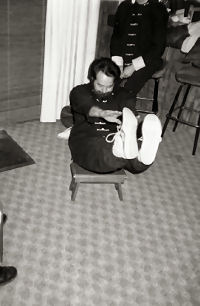 to use this stool for training?”
to use this stool for training?”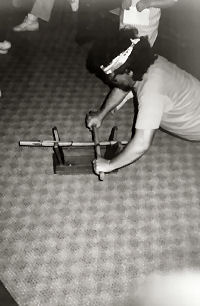 dynamic, which when reconciled, resulted in
a combination of inner ear training, muscular
development, and ancillary benefit to the ligaments.
dynamic, which when reconciled, resulted in
a combination of inner ear training, muscular
development, and ancillary benefit to the ligaments. To the left, Archie has the stool upside
down and is using it as a platform for an Arnis stick.
Once the stick is placed, Archie takes a second stick,
sets it perpendicular onto the first, then begins
extended arm push-ups. The challenge here is maintaining
balance and control of the sticks (both front to rear,
and side to side), which are quite perfidious in their
contact, while executing a very slow and controlled
push-up without destabilizing, sliding forward, or
dropping to either side.
To the left, Archie has the stool upside
down and is using it as a platform for an Arnis stick.
Once the stick is placed, Archie takes a second stick,
sets it perpendicular onto the first, then begins
extended arm push-ups. The challenge here is maintaining
balance and control of the sticks (both front to rear,
and side to side), which are quite perfidious in their
contact, while executing a very slow and controlled
push-up without destabilizing, sliding forward, or
dropping to either side.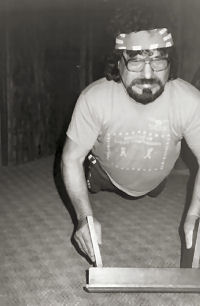 dictated by the stool and gravity.
dictated by the stool and gravity.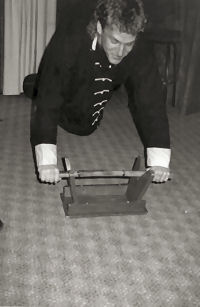 However, the narrow width of the stool
creates its own dynamic and enhances tension on the
bicep. Most challenging is the narrow hand grip on the
legs of the stool. To execute the technique properly,
nothing less than a viselike hand grip will suffice.
That is the ultimate benefit of this drill.
However, the narrow width of the stool
creates its own dynamic and enhances tension on the
bicep. Most challenging is the narrow hand grip on the
legs of the stool. To execute the technique properly,
nothing less than a viselike hand grip will suffice.
That is the ultimate benefit of this drill.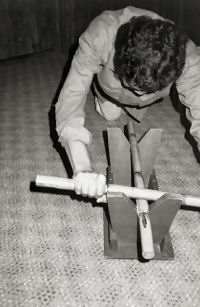 struggle
with balance, the tilting to the left, and the
accommodating narrow grip on the stick in an effort to
offset the instability. Compare this photo to the
previous one of Archibeque. Note that Archie never
cheats during his exercise. His hands are on the wide
endposts of the stick, where the stress challenge is
maximized.
struggle
with balance, the tilting to the left, and the
accommodating narrow grip on the stick in an effort to
offset the instability. Compare this photo to the
previous one of Archibeque. Note that Archie never
cheats during his exercise. His hands are on the wide
endposts of the stick, where the stress challenge is
maximized.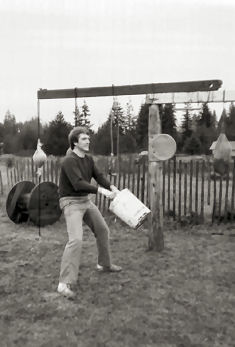
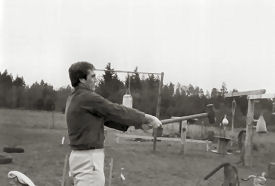
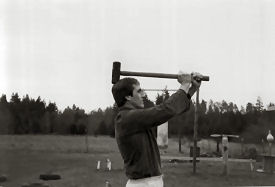
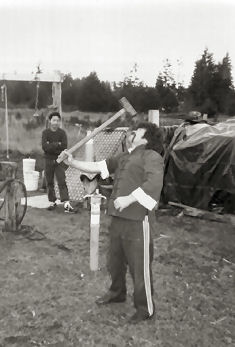
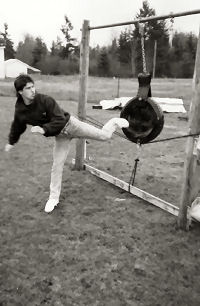
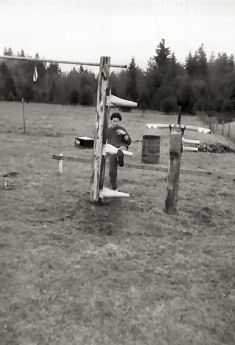 This photo shows just how useful a visit to
the state surplus store can be. In a prior lifetime,
these kicking targets were highway markers.
This photo shows just how useful a visit to
the state surplus store can be. In a prior lifetime,
these kicking targets were highway markers. 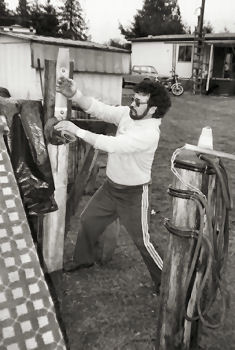 student would circle about the target,
impacting each striking surface, while maintaining
control of the center line.
student would circle about the target,
impacting each striking surface, while maintaining
control of the center line.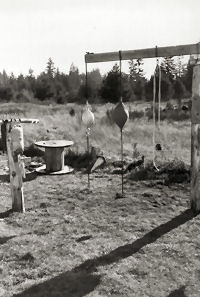


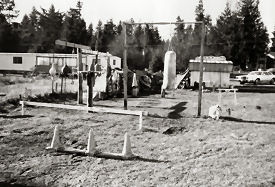
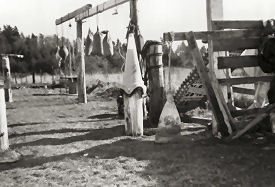
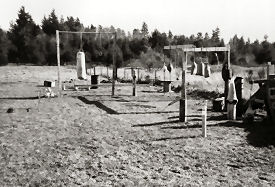
 I have recalled that on several occasions,
I felt the hand of death about to tap my shoulder.
I have recalled that on several occasions,
I felt the hand of death about to tap my shoulder. 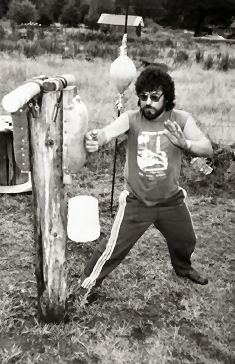 The final years of Archie’s practice were
in the structural Gun Fu Dojo. That school was built by
hand from the ground up. It came about from the
generosity of Archibeque’s friends and students over the
course of a year in the 1980s. Mentoring the project was
Gary Foremen, one of the Black Belts, and a master at
finding abandoned resources.
The final years of Archie’s practice were
in the structural Gun Fu Dojo. That school was built by
hand from the ground up. It came about from the
generosity of Archibeque’s friends and students over the
course of a year in the 1980s. Mentoring the project was
Gary Foremen, one of the Black Belts, and a master at
finding abandoned resources.